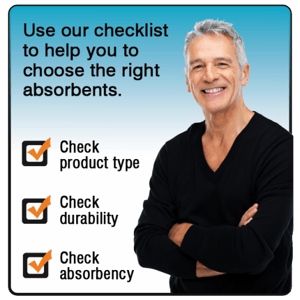As you know, there are four basic types of absorbents: mats, socks and booms, pillows, and granular. Understanding these varieties is the first step on our checklist when choosing the right absorbents.
The key uses for absorbent mats are to catch leaks around machinery, soak up spills, and line walkways. Your buyers should look for these five things:
 Durability. Will the mat be used in a light foot traffic area or have to endure cart or forklift traffic?
Durability. Will the mat be used in a light foot traffic area or have to endure cart or forklift traffic?- Duration. How long with the mat be used? Will it be there only as long as it takes to absorb a spill or will it be in a long-term area such as in a walkway?
- Absorbency and Retention. How much liquid will the mat need to absorb? How long will it be expected to hold that liquid?
- Type of Liquid. Will the mat need to absorb oil, solvents, coolants, acids, and/or water? Some can repel water and absorb the other liquids. The best option depends on your buyer's application.
- Shape and Size. What amount of space does the mat need to cover? Mats come in rectangular shapes or in rolls. The key here is to determine the size of the space to be covered and how quickly the spill needs to be absorbed. If it is needed for small spills and quick deployment, the rectangular pads might work best. If it needs to cover a larger area for a long period of time the rolls will no doubt be the best option.
Every one of these choices has cost implications. While choosing a high absorbent mat for a spill might appear to be the best option, if the spill is light, your buyer will be tossing away the mat and not making full use of its capabilities. In those situations, our perforated rolls might be an excellent option since your buyer can tear off only what's needed.
In another example, if a lightweight mat is placed in a high traffic area, it will need to be replaced much more frequently than with a heavyweight mat.
I'll also note that if the mat appears dirty before it's been used to full capacity, it can end up being disposed of sooner than needed. That's why I really like our camo sorbents, which not only look good but allow the mat to readily be used to full capacity.
Tap Our Experience and Expertise
I hope this post has helped you gain insight into the key things you should be looking for when helping your buyers select industrial absorbent mats.
While absorbents seem very simple, they can be deceiving and your buyer really needs to consider all aspect of the mats’ application. This includes the appropriateness for the application, initial purchase price, frequency of replacement, and disposal costs.
For further information I've written about the three critical factors in making a purchase of industrial sorbents.
Let us know how we can help. Use our contact page or call us at 888-653-7509.

